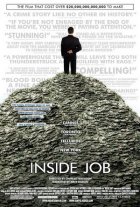
Inside Job Page #6
Inside Job transcript – Sony Pictures – September 2010
27
So we thought he was gonna take action. But, as the conversation continued, it was
clear he was stuck with his ideology.
We met again with Greenspan in '05. Often we met with him twice a year, and never
less than once a year. And he wouldn't change his mind.
{ALAN GREENSPAN DECLINED
TO BE INTERVIEWED FOR THIS FILM.}
01:
34:45.02{CHRISTOPHER COX
SEC CHAIRMAN:
JUNE 2, 2005}
CHRISTOPHER COX:
In this amazing world of instant global communications, the freeand efficient movement of capital is helping to create the greatest prosperity in human
history.
{THE SECURITIES AND EXCHANGE COMMISSION
CONDUCTED NO MAJOR INVESTIGATIONS OF THE
INVESTMENT BANKS DURING THE BUBBLE.}
01:
35:01.04{OCTOBER 7, 2008}
REP. PETER WELCH: A hundred and forty six people were cut from the enforcement
division of the e-, SEC; is that what you also testified to?
{LYNN E. TURNER
FORMER CHIEF ACCOUNTANT
SECURITIES AND EXCHANGE COMMISSION}
LYNN E. TURNER:
Yes. Yeah, I, I think there has been a, a, a systematic gutting, orwhatever you want to call it, of the agency and its capability, through cutting back of
staff.
01:
35:20.03REP. PETER WELCH: The SEC Office of, uh, Risk Management was reduced to a staff,
did you say, of one?
LYNN E. TURNER:
Yeah. When that gentleman would go home at night, he could turnthe lights out.
Inside Job transcript – Sony Pictures – September 2010
28
01:
35:33.17NARRATOR:
During the bubble, the investment banks were borrowing heavily, to buymore loans, and create more CDOs.
The ratio between borrowed money and the banks' own money was called leverage.
The more the banks borrowed, the higher their leverage.
In 2004, Henry Paulson, the CEO of Goldman Sachs, helped lobby the Securities and
Exchange Commission to relax limits on leverage, allowing the banks to sharply
increase their borrowing.
01:
36:05.14{KENNETH ROGOFF
PROFESSOR OF ECONOMICS, HARVARD}
KENNETH ROGOFF:
The SEC somehow decided to let investment banks gamble a lotmore. That was nuts. I don't know why they did that, but they did that.
{ON APRIL 28, 2004, THE SEC MET TO CONSIDER
LIFTING LEVERAGE LIMITS ON THE INVESTMENT BANKS}
01:
36:21.20COMMISSIONER HARVEY J. GOLDSCHMID: We've said these are the big guys and
clearly that's true. But that means if anything goes wrong, it's going to be an awfully big
mess.
[LAUGHTER]
DIRECTOR ANNETTE L. NAZARETH: At these levels, you obviously are dealing with
the most highly sophisticated financial institutions.
01:
36:37.13COMMISSIONER ROEL C. CAMPOS: These are the firms that do most of the
derivative activity in the United States. We talked to some of them as to what their
comfort level was.
DIRECTOR ANNETTE L. NAZARETH: The firms actually thought that the number was,
uh, appropriate.
CHAIRMAN WILLIAM DONALDSON: Do the commissioners vote to adopt the rule
amendments and new rules as recommended by the staff?
Inside Job transcript – Sony Pictures – September 2010
29
ALL:
Yes.WILLIAM DONALDSON: We do indeed. Unanimous.
And we are adjourned.
01:
37:03.00{DANIEL ALPERT
MANAGING DIRECTOR
WESTWOOD CAPITAL}
DANIEL ALPERT:
The degree of leverage in the financial system, uh, becameabsolutely frightening; investment banks leveraging up to the level of, you know, 33 to 1.
Uh, which means that a tiny, 3-percent decrease in the value of their asset base would
leave them insolvent.
01:
37:22.10NARRATOR:
There was another ticking time bomb in the financial system: AIG, theworld's largest insurance company, was selling huge quantities of derivatives, called
credit default swaps.
For investors who owned CDOs, credit default swaps worked like an insurance policy.
An investor who purchased a credit default swap paid AIG a quarterly premium. If the
CDO went bad, AIG promised to pay the investor for their losses.
01:
37:52.23 But unlike regular insurance, speculators could also buy credit defaultswaps from AIG in order to bet against CDOs they didn't own.
01:
38:04.13SATYAJIT DAS:
In insurance, you can only insure something you own. Let's say youand I own property; I own a house. I can only insure that house once. The derivatives
universe essentially enables anybody to actually insure that house. So you could insure
that; somebody else could do that. So 50 people might insure my house.
So what happens is, if my house burns down, now the number of losses in the system
becomes proportionately larger.
01:
38:31.01NARRATOR:
Since credit default swaps were unregulated, AIG didn't have to put asideany money to cover potential losses. Instead, AIG paid its employees huge cash
Inside Job transcript – Sony Pictures – September 2010
30
bonuses as soon as contracts were signed. But if the CDOs later went bad, AIG would
be on the hook.
NOURIEL ROUBINI:
People were essentially being rewarded for taking massive risks.Uh, in good times, they generate short-term revenues and profits, and therefore
bonuses. But that's gonna lead to the firm to be bankrupt over time. That's a totally
distorted system of compensation.
01:
39:07.13NARRATOR:
AIG's Financial Products Division in London issued 500 billion dollarsworth of credit default swaps during the bubble, many of them for CDOs backed by
subprime mortgages.
The 400 employees at AIGFP made 3.5 billion dollars between 2000 and 2007. Joseph
Cassano, the head of AIGFP, personally made 315 million dollars.
01:
39:34.00{JOSEPH CASSANO ON AN AIG CONFERENCE CALL
WITH INVESTORS, AUGUST 2007.}
JOSEPH CASSANO:
It's hard for us, with, and with, without being flippant, to even seea scenario, within any kind of realm of reason, that would see us losing one dollar in any
of those transactions.
01:
39:48.05NARRATOR:
In 2007, AIG's auditors raised warnings. One of them, Joseph St. Denis,resigned in protest after Cassano repeatedly blocked him from investigating AIGFP's
accounting.
REP. HENRY WAXMAN: Let me tell you one person that didn't get a bonus while
everybody else was getting bonuses:
{HENRY WAXMAN
CHAIRMAN, HOUSE OVERSIGHT COMMITTEE}
– that was St. Denis, Mr. St. Denis, who tried to alert the two of you to the fact that you
were running into big problems. He quit in frustration, and he didn't get a bonus.
01:
40:16.29Inside Job transcript – Sony Pictures – September 2010
31
NARRATOR:
In 2005, Raghuram Rajan, then the chief economist of the InternationalMonetary Fund, delivered a paper at the annual Jackson Hole Symposium, the most
elite banking conference in the world.
CHARLES FERGUSON: Who was in the audience?
RAGHURAM RAJAN:
CHIEF ECONOMIST (2003-2007)
INTERNATIONAL MONETARY FUND (IMF)}
RAGHURAM RAJAN:
It was, uh, I guess, the central bankers of the world. Um, rangingfrom Mr. Greenspan himself; Ben Bernanke; Larry Summers was there; Tim Geithner
was there.
Translation
Translate and read this script in other languages:
Select another language:
- - Select -
- 简体中文 (Chinese - Simplified)
- 繁體中文 (Chinese - Traditional)
- Español (Spanish)
- Esperanto (Esperanto)
- 日本語 (Japanese)
- Português (Portuguese)
- Deutsch (German)
- العربية (Arabic)
- Français (French)
- Русский (Russian)
- ಕನ್ನಡ (Kannada)
- 한국어 (Korean)
- עברית (Hebrew)
- Gaeilge (Irish)
- Українська (Ukrainian)
- اردو (Urdu)
- Magyar (Hungarian)
- मानक हिन्दी (Hindi)
- Indonesia (Indonesian)
- Italiano (Italian)
- தமிழ் (Tamil)
- Türkçe (Turkish)
- తెలుగు (Telugu)
- ภาษาไทย (Thai)
- Tiếng Việt (Vietnamese)
- Čeština (Czech)
- Polski (Polish)
- Bahasa Indonesia (Indonesian)
- Românește (Romanian)
- Nederlands (Dutch)
- Ελληνικά (Greek)
- Latinum (Latin)
- Svenska (Swedish)
- Dansk (Danish)
- Suomi (Finnish)
- فارسی (Persian)
- ייִדיש (Yiddish)
- հայերեն (Armenian)
- Norsk (Norwegian)
- English (English)
Citation
Use the citation below to add this screenplay to your bibliography:
Style:MLAChicagoAPA
"Inside Job" Scripts.com. STANDS4 LLC, 2025. Web. 23 Feb. 2025. <https://www.scripts.com/script/inside_job_42>.







Discuss this script with the community:
Report Comment
We're doing our best to make sure our content is useful, accurate and safe.
If by any chance you spot an inappropriate comment while navigating through our website please use this form to let us know, and we'll take care of it shortly.
Attachment
You need to be logged in to favorite.
Log In